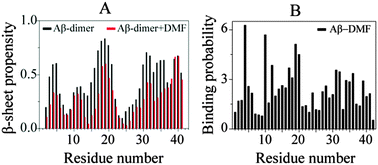The inhibitory mechanism of a fullerene derivative against amyloid-β peptide aggregation: an atomistic simulation study†
Abstract
Alzheimer's disease (AD) is associated with the pathological self-assembly of amyloid-β (Aβ) peptides into β-sheet enriched fibrillar aggregates. Aβ dimers formed in the initial step of Aβ aggregation were reported to be the smallest toxic species. Inhibiting the formation of β-sheet-rich oligomers and fibrils is considered as the primary therapeutic strategy for AD. Previous studies reported that fullerene derivatives strongly inhibit Aβ fibrillation. However, the underlying inhibitory mechanism remains elusive. As a first step to understand fullerene-modulated full-length Aβ aggregation, we investigated the conformational ensemble of the Aβ1–42 dimer with and without 1,2-(dimethoxymethano)fullerene (DMF) – a more water-soluble fullerene derivative – by performing a 340 ns explicit-solvent replica exchange molecular dynamics simulation. Our simulations show that although disordered states are the most abundant conformations of the Aβ1–42 dimer, conformations containing diverse extended β-hairpins are also populated. The first most-populated β-hairpins involving residues L17–D23 and A30–V36 strongly resemble the engineered β-hairpin which is a building block of toxic Aβ oligomers. We find that the interaction of DMFs with Aβ peptides greatly impedes the formation of such β-hairpins and inter-peptide β-sheets. Binding energy analyses demonstrate that DMF preferentially binds not only to the central hydrophobic motif LVFFA of the Aβ peptide as suggested experimentally, but also to the aromatic residues including F4 and Y10 and the C-terminal hydrophobic region I31–V40. This study reveals a complete picture of the inhibitory mechanism of full-length Aβ1–42 aggregation by fullerenes, providing theoretical insights into the development of drug candidates against AD.


 Please wait while we load your content...
Please wait while we load your content...